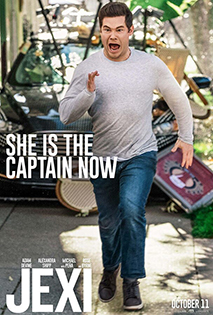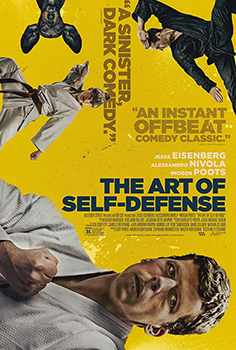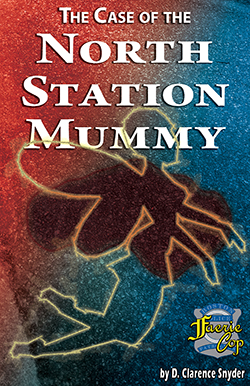Postmodern Electric Dreams (Jexi)
Jexi is a lonely guy expands his life romantic comedy. It’s not terribly groundbreaking in terms of story or devices, but what it lacks in innovation it makes up for in being genuinely funny. I found myself laughing from start to finish.
 The titular character is an “intelligent assistant” software installed on some unnamed brand of smartphone. Voiced by Rose Byrne, she promises to make Phil’s (Adam Devine) life better. Brash and foul mouthed – Jexi is rated R for language – she berates him into asking out the girl from the bike shop (Alexandra Shipp). Things go awry because Jexi’s 200,000 software anomalies cause her to develop emotions for Phil.
The titular character is an “intelligent assistant” software installed on some unnamed brand of smartphone. Voiced by Rose Byrne, she promises to make Phil’s (Adam Devine) life better. Brash and foul mouthed – Jexi is rated R for language – she berates him into asking out the girl from the bike shop (Alexandra Shipp). Things go awry because Jexi’s 200,000 software anomalies cause her to develop emotions for Phil.
It would be easy to discuss this film as a cautionary tale about over indulgence in social media, lack of privacy, and reliance on “smart” devices. While there is a sort of “look what can happen to you” implication, the film is really just having a good time with the material and striking chords at the heart of the human condition enmired by the Internet Of Things.
As a character, Phil is the essence of this condition. Despite having a degree in journalism, his job is to write lists for a click-bait encouraging news site. His boss (played by the ever brilliant Michael Pena) demands that one of their lists goes viral every day. Naturally, Phil is completely tethered to his phone. He can’t even navigate his way to his home or office without Google maps.
Adam Devine is an excellent brunt for the film’s jokes and pratfall-esque humor. Jexi’s absence of filter – and Phil’s acceptance of user agreement without reading it – gives her free reign to play havoc with Phil and consumer technology humor.
Jexi is a fun film that lives up to the trailer, which didn’t give away all the jokes.
 Joaquin Phoenix does an excellent job portraying this descent from illness into madness. The film focuses so much on him that it doesn’t leave much room for the other actors, though the casting is on point. Robert De Niro as a sort of gruff “Late Night” host is good, of course, and fits in well as a sort of background to Joker’s developing mania – better than if he were brought more central or used for his “star power.”
Joaquin Phoenix does an excellent job portraying this descent from illness into madness. The film focuses so much on him that it doesn’t leave much room for the other actors, though the casting is on point. Robert De Niro as a sort of gruff “Late Night” host is good, of course, and fits in well as a sort of background to Joker’s developing mania – better than if he were brought more central or used for his “star power.” A young man with Down syndrome, Zak (played by Zack Gottsagen) escapes the nursing home where he lives to pursue his dream to go to a professional wrestling school taught by his idol – The Salt Water Redneck (played by Thomas Haden Church). Along the way he teams up with a grifter, Tyler (played by Shia LaBeouf), and the two embark on a “road” movie along the Outer Banks of North Carolina (played by the State of Georgia). They are each pursued by those who would drag them back – notably Dakota Johnson as a volunteer at the nursing home. They bond over being men “on the run” and become friends.
A young man with Down syndrome, Zak (played by Zack Gottsagen) escapes the nursing home where he lives to pursue his dream to go to a professional wrestling school taught by his idol – The Salt Water Redneck (played by Thomas Haden Church). Along the way he teams up with a grifter, Tyler (played by Shia LaBeouf), and the two embark on a “road” movie along the Outer Banks of North Carolina (played by the State of Georgia). They are each pursued by those who would drag them back – notably Dakota Johnson as a volunteer at the nursing home. They bond over being men “on the run” and become friends. The plot is fairly straightforward. An overtly suppressed staff accountant, Casey (Eisenberg), is mugged one night. Terrified of his own shadow, Casey seeks the means for protecting himself and overcoming his crippling fear. On his journey through toxic-masculinity, he wanders into a karate studio and its cult-like and dangerous world of hierarchical belts, led by a sensei (Alessandro Nivola) who demands his students give a full measure of devotion. Casey’s exploration into this exaggerated world transforms him, pretty much exactly as Sensei plans.
The plot is fairly straightforward. An overtly suppressed staff accountant, Casey (Eisenberg), is mugged one night. Terrified of his own shadow, Casey seeks the means for protecting himself and overcoming his crippling fear. On his journey through toxic-masculinity, he wanders into a karate studio and its cult-like and dangerous world of hierarchical belts, led by a sensei (Alessandro Nivola) who demands his students give a full measure of devotion. Casey’s exploration into this exaggerated world transforms him, pretty much exactly as Sensei plans.